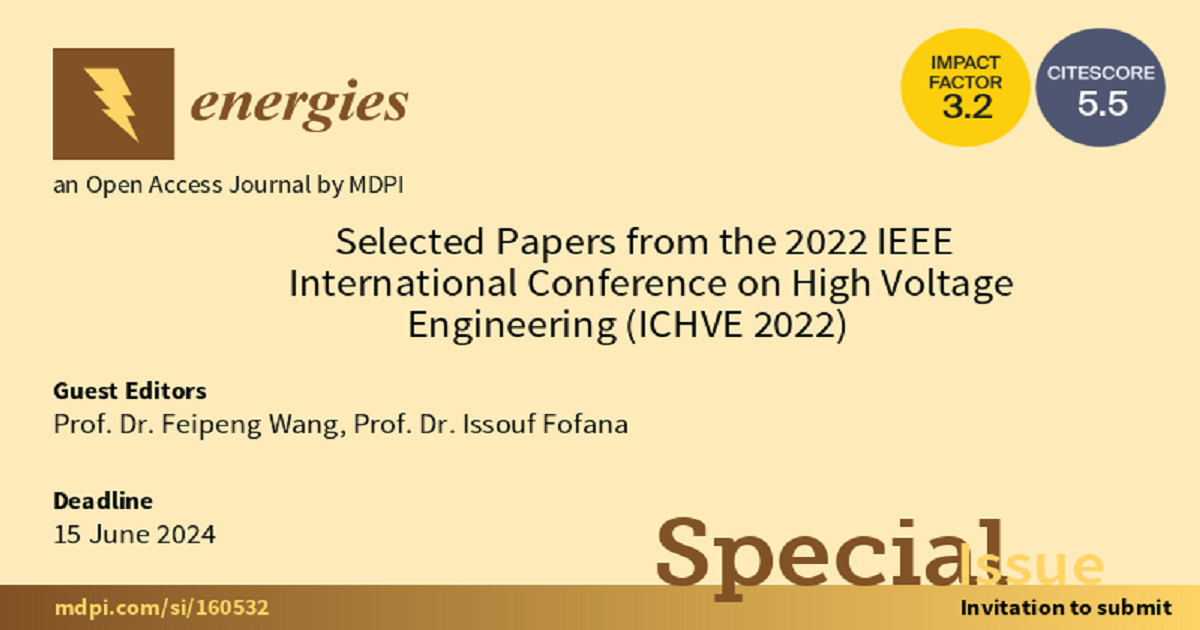Selected Papers from the 2022 IEEE International Conference on High Voltage Engineering (ICHVE 2022)
A special issue of Energies (ISSN 1996-1073). This special issue belongs to the section "F6: High Voltage".
Deadline for manuscript submissions: closed (15 June 2024) | Viewed by 1967

Special Issue Editors
Interests: electrical insulating materials; high voltage devices; insulating liquids
Interests: dielectrics and electrical insulating materials; insulating fluids; diagnostic and monitoring; atmospheric icing of power network equipment; electric discharge and lightning-related phenomena; HV testing techniques and computer modeling
Special Issues, Collections and Topics in MDPI journals
Special Issue Information
Dear Colleagues,
The 2022 IEEE International Conference on High Voltage Engineering (ICHVE 2022) was held on 26–29 September 2022 in Chongqing, China. It was organized by Chongqing University (China) and endorsed by the IEEE Dielectrics and Electrical Insulation Society (DEIS). This conference (http://www.ichve2022.org/) has attracted a great deal of attention from international researchers in the field of high-voltage engineering. This forum not only provided an excellent platform to share knowledge and experiences on high voltage engineering, but also provided the opportunity to present the latest achievements in power engineering, including topics such as ultra-high voltage, smart grids, and new insulation materials and their dielectric properties. Now, there is an opportunity to publish your paper in Energies.
Prof. Dr. Feipeng Wang
Prof. Dr. Issouf Fofana
Guest Editors
Manuscript Submission Information
Manuscripts should be submitted online at www.mdpi.com by registering and logging in to this website. Once you are registered, click here to go to the submission form. Manuscripts can be submitted until the deadline. All submissions that pass pre-check are peer-reviewed. Accepted papers will be published continuously in the journal (as soon as accepted) and will be listed together on the special issue website. Research articles, review articles as well as short communications are invited. For planned papers, a title and short abstract (about 100 words) can be sent to the Editorial Office for announcement on this website.
Submitted manuscripts should not have been published previously, nor be under consideration for publication elsewhere (except conference proceedings papers). All manuscripts are thoroughly refereed through a single-blind peer-review process. A guide for authors and other relevant information for submission of manuscripts is available on the Instructions for Authors page. Energies is an international peer-reviewed open access semimonthly journal published by MDPI.
Please visit the Instructions for Authors page before submitting a manuscript. The Article Processing Charge (APC) for publication in this open access journal is 2600 CHF (Swiss Francs). Submitted papers should be well formatted and use good English. Authors may use MDPI's English editing service prior to publication or during author revisions.
Keywords
- electromagnetic fields
- transients, grounding systems, and electromagnetic compatibility (EMC)
- sensing, monitoring, and diagnostics
- high voltage testing and measurement
- aging, space charge, and maintenance
- advanced materials and insulation systems
- high voltage systems and smart technologies
- high voltage direct current (HVDC) technologies and applications
- industrial applications of high voltage
Benefits of Publishing in a Special Issue
- Ease of navigation: Grouping papers by topic helps scholars navigate broad scope journals more efficiently.
- Greater discoverability: Special Issues support the reach and impact of scientific research. Articles in Special Issues are more discoverable and cited more frequently.
- Expansion of research network: Special Issues facilitate connections among authors, fostering scientific collaborations.
- External promotion: Articles in Special Issues are often promoted through the journal's social media, increasing their visibility.
- e-Book format: Special Issues with more than 10 articles can be published as dedicated e-books, ensuring wide and rapid dissemination.
Further information on MDPI's Special Issue polices can be found here.
Related Special Issues
- Selected Papers from 2020 IEEE International Conference on High Voltage Engineering (ICHVE 2020) in Energies (17 articles)
- Selected Papers from 2018 IEEE International Conference on High Voltage Engineering (ICHVE 2018) in Energies (18 articles)
- Selected Papers from 2016 IEEE International Conference on High Voltage Engineering (ICHVE 2016) in Energies (23 articles)






